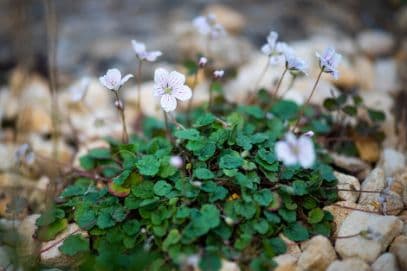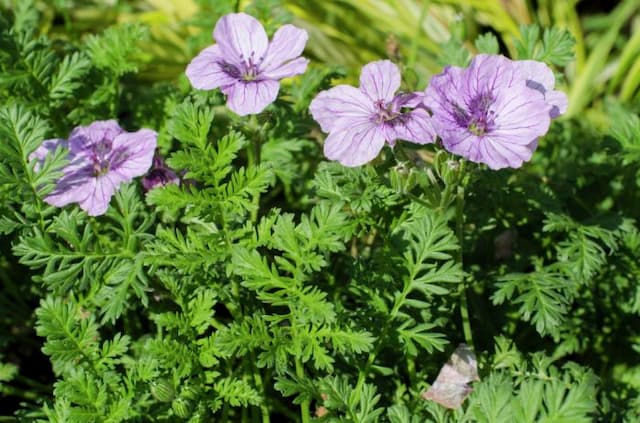Bishop's Form Erodium × variabile 'William Bishop'

ABOUT
Erodium × variabile 'William Bishop' is a charming perennial known more commonly as the Bishop's Heron's Bill. This particular variety boasts a low-growing, mat-forming habit, providing a lush ground cover that can add beauty to gardens and landscapes without overshadowing nearby plants. Its foliage is semi-evergreen, which means it retains its leaves for most of the year, contributing a vibrant green backdrop for its more colorful features. The leaves are delicately dissected, giving them a feathery appearance that is soft to the touch. The true allure of Bishop's Heron's Bill lies in its flowers. Blossoming generously from late spring to summer, the plant displays a profusion of vividly colored blooms. The flowers are characterized by their unique shape, reminiscent of a stork's bill, which is a trait shared amongst members of its species. Each flower showcases five rounded petals that come together to form a cup-like shape. The petals are a deep pink hue, with a distinctive dark purple-maroon spot at their base, adding a striking contrast and eye-catching allure. The presence of these dark markings is a defining feature that adds to the ornamental value of the plant. As a flowering ground cover, Bishop's Heron's Bill is often appreciated for its ability to spread a tapestry of color along borders, rock gardens, and even spilling over walls or containers. Its charming flowers, combined with its lush foliage, make it a popular choice for gardeners looking to inject long-lasting color and texture into their garden designs.
About this plant
 Names
NamesFamily
Geraniaceae
Synonyms
Bishop's Form, William Bishop Hardy Geranium, William Bishop Cranesbill
Common names
Erodium × variabile 'William Bishop'.
 Toxicity
ToxicityTo humans
Bishop's Hat is not commonly known to be toxic to humans. There is a lack of substantial evidence indicating that Erodium × variabile 'William Bishop', commonly known as Bishop's Hat, is poisonous upon ingestion. Therefore, no specific symptoms of poisoning are generally associated with this plant for humans. Accidental ingestion is unlikely to cause harm, but as with any non-food plant, it's prudent to avoid consuming it.
To pets
Bishop's Hat is not widely recognized as a toxic plant to pets. There is limited information available on the toxicity of Erodium × variabile 'William Bishop', commonly referred to as Bishop's Hat, to domestic animals such as cats and dogs. In the absence of specific toxicological data, it is generally advised that pets should not eat ornamental plants, but if Bishop's Hat is ingested by a pet, it is not expected to cause serious poisoning. Always monitor pets and consult with a veterinarian if you observe any unusual symptoms following ingestion of any plant material.
 Characteristics
CharacteristicsLife cycle
Perennials
Foliage type
Evergreen
Color of leaves
Green
Flower color
Pink
Height
6 inches (15 cm)
Spread
12 inches (30 cm)
Plant type
Herb
Hardiness zones
8
Native area
Mediterranean
Benefits
 General Benefits
General Benefits- Attracts pollinators: The flowers can attract bees and butterflies which are vital for the pollination of many plants.
- Low maintenance: Once established, it requires minimal care, making it ideal for gardeners seeking low-maintenance options.
- Drought-tolerant: Adapted to survive with little water, making it suitable for xeriscaping or regions with water restrictions.
- Ground cover: Its growth habit allows it to spread across the ground, suppressing weeds and reducing soil erosion.
- Aesthetic appeal: The pink to purple flowers add a splash of color to gardens, rockeries, and borders.
- Adaptable to various soils: It can thrive in a range of soil types, provided they are well-draining.
- Long blooming season: Offers prolonged periods of flowering, which can enhance a garden's visual interest throughout the season.
- Cold-hardy: It can withstand low temperatures, making it suitable for gardens in cooler climates.
- Non-invasive: Unlike some ground covers, Erodium × variabile 'William Bishop' does not aggressively overtake spaces and is easy to control.
 Medical Properties
Medical PropertiesThis plant is not used for medical purposes.
 Air-purifying Qualities
Air-purifying QualitiesThis plant is not specifically known for air purifying qualities.
 Other Uses
Other Uses- Erodium 'William Bishop' can be pressed and used in botanical art and craft projects for decorating keepsakes, creating unique pieces of framed artwork, or enhancing the visual appeal of greeting cards.
- The spent flowers and leaves of the plant can be composted to contribute to nutrient cycling and improve soil structure in the garden.
- Small cuttings of this plant can serve as an all-natural filler for miniature bouquets or terrariums due to its compact growth and attractive foliage.
- The plant's dense, low-growing habit makes it useful as a living mulch to suppress weeds and retain moisture in garden beds.
- Erodium 'William Bishop' can be used in sensory gardens for its textural leaves and the subtle, soft touch experience it provides when brushed against.
- In educational settings, this plant can be used to demonstrate plant propagation techniques, especially for lessons on splitting and dividing perennial plants.
- The variety's resilience and drought tolerance make it suitable as a model organism for studying plant adaptations to arid conditions in botanical research.
- Dried Erodium 'William Bishop' can make attractive additions to dried flower arrangements for those seeking a more permanent, maintenance-free display.
- As a natural form of garden decoration, Erodium 'William Bishop' can be creatively implemented in fairy gardens, providing a whimsical grounding cover that complements miniature structures.
- Erodium 'William Bishop' can be used in photography as a delicate foreground plant to add depth and interest to close-up shots of insects, other plants, or garden features.
Interesting Facts
 Feng Shui
Feng ShuiBishop's weed is not used in Feng Shui practice.
 Zodiac Sign Compitability
Zodiac Sign CompitabilityBishop's weed is not used in astrology practice.
 Plant Symbolism
Plant Symbolism- Endurance: Erodiums, also commonly known as "storksbills", are hardy plants that can survive in challenging conditions, making them a symbol of endurance and resilience.
- Adaptability: The 'William Bishop' variety, like other storksbills, is adaptable and can thrive in various environments, symbolizing flexibility and the ability to thrive in changing circumstances.
- Grace: Storksbills have delicate and elegant flowers, which often leads to their association with grace and beauty.
- Protection: Some cultures believe that Erodium species have protective qualities, possibly because many varieties form dense mats that can protect the soil underneath.
 Water
WaterThe Bishop's Hat should be watered regularly to maintain moist but not waterlogged soil, especially during its growth season in spring and summer. Water the plant thoroughly until water runs from the bottom of the pot or until the soil is evenly saturated if planted in the ground, usually requiring about 1-2 gallons for an average-sized garden bed every week. Cut back on watering in the fall and winter when the plant is dormant, to approximately once every two weeks, depending on the climate and weather conditions. Always check the top inch of the soil for dryness before watering again to avoid overwatering.
 Light
LightBishop's Hat flourishes in partial to full sunlight. The ideal position is one where it receives at least four to six hours of direct sunlight daily, with some afternoon shade in hotter climates to protect it from intense, scorching heat. Well-lit positions with morning sunlight and dappled afternoon light are often beneficial for vibrant foliage and bloom production.
 Temperature
TemperatureBishop's Hat prefers temperatures between 60 and 75 degrees Fahrenheit but can endure minimum temperatures down to about 30 degrees Fahrenheit. It is not tolerant of extreme cold and should be protected from frost. Ideally, ensure the plant is in a location where sudden temperature drops are unlikely, especially during the blooming season.
 Pruning
PruningPrune Bishop's Hat to remove dead flowers and encourage a second bloom, usually done immediately after the first flowering phase ends. Additionally, pruning can help maintain its shape and size, which is especially helpful if grown in a container or small garden space. It's best to prune in the late winter or early spring before new growth begins.
 Cleaning
CleaningAs needed
 Soil
SoilThe Bishops's Form cranesbill thrives best in well-draining soil enriched with organic matter, such as compost or peat moss. The ideal pH for this cranesbill variety generally ranges from slightly acidic to neutral (pH 6.0 to 7.0). A mix of garden soil, compost, and sharp sand or perlite tends to work well, ensuring good drainage while retaining some moisture.
 Repotting
RepottingThe Bishop's Form cranesbill is not typically grown as a houseplant and thus does not require frequent repotting. When grown in containers outdoors, it may need repotting every two to three years to refresh the soil and accommodate root growth.
 Humidity & Misting
Humidity & MistingThe Bishop's Form cranesbill is adaptable to a wide range of humidity levels and does not have specific humidity requirements. It thrives in outdoor environments where the humidity is naturally regulated.
 Suitable locations
Suitable locationsIndoor
Ensure bright light, well-draining soil, and moderate watering.
Outdoor
Plant in sun or partial shade with well-drained soil and space.
Hardiness zone
5-8 USDA
 Life cycle
Life cycleErodium × variabile 'William Bishop', commonly known as the Bishop's Form Storksbill, begins its life as a seed, which, when sown in fertile, well-draining soil and given sufficient warmth and moisture, will germinate. The seedling stage follows, characterized by the emergence of the cotyledons, the first leaves of the plant, which will photosynthesize and provide energy for further growth. As the plant enters the vegetative stage, true leaves develop, and the root system becomes established, allowing for increased nutrient and water uptake. During the flowering stage, the Erodium × variabile 'William Bishop' produces its distinctive five-petalled, pink flowers with darker magenta veins, which attract pollinators and can result in the production of seeds. After pollination and subsequent fertilization, seed pods develop, eventually releasing seeds once matured, thereby completing the reproductive cycle. As a perennial, the plant then either dies back to the ground during the winter, in colder climates, or continues to grow in milder conditions, with the cycle repeating each growing season.
 Propogation
PropogationPropogation time
Spring to Summer
Erodium × variabile 'Bishop's Form', commonly known as Bishop's Form Stork's Bill, can be propagated most effectively through the use of stem cuttings. This method is typically performed in late spring or early summer when the plant is actively growing. A gardener would select a healthy, non-flowering stem and cut a segment ranging from 4 to 6 inches (approximately 10 to 15 cm) in length, making sure to include at least a couple of leaf nodes. The cut end is often dipped in rooting hormone to encourage root growth, although this is not strictly necessary. The cutting is then planted in a pot filled with a well-draining potting mix, such as a mixture of peat and perlite or sand. The pot should be kept moist but not waterlogged, and placed in a warm, bright area without direct sunlight until roots have developed, which usually takes a few weeks. After the cutting has rooted, it can be transplanted to its final location.



![Cranesbill [Blue Sunrise]](/_next/image?url=https%3A%2F%2Fplants-admin.emdemapps.com%2Fimages%2Fplants%2F%2Fimages%2F604b638d45948.png&w=640&q=75)





![Cranesbill [Dreamland]](/_next/image?url=https%3A%2F%2Fplants-admin.emdemapps.com%2Fimages%2Fplants%2F%2Fimages%2F604b53d4c45a1.png&w=640&q=75)